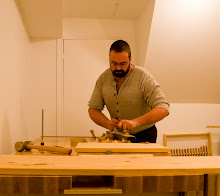Ripping boards to width should not be a task that makes terribly great demands on the skill of the sawyer.
Famous last words, eh?
Ripping requires more brawn than brain, in general, but a point was driven home for me last evening that I'd like to pass on.
I've seen several videos where people mention how much they prefer to rip smaller pieces of stock vertically in the vise rather than horizontally on the horses. I can understand this from an ergonomic perspective. Totally. There is, however, a potential problem. The potential problem is caused by the angle of attack. Look at the image below:
Here we see my rip saw buried in a piece of cribbing (the hardwood 4x4s of uncertain parentage that are used on big flat-bed trucks to keep ugly pieces of material being shipped from tearing up the deck of the truck). The saw is horizontal. I can merrily saw away in this position, but the saw will go in whatever direction the saw is going. With the saw perpendicular to the work, controlling the saw - changing its direction - is very, very difficult. To change the direction of the saw I would need to tip the handle down until the saw meets the work at about a 45 degree angle. This means that to get the angle you need to control the saw when sawing in the vise you need to have the work sticking out far enough that it's liable to chatter. Either that or you'll be on your knees doing the sawing. I got lucky on this particular cut and it was dead-nuts from the beginning, so I just kept the saw horizontal and it followed the line like I was paying it money to do so. That was the first of two rips. I cut that 4x4 down to make a 4x3 and a 1x4, then I cut a 1x1 out of the 1x4, and on that cut I screwed up the line twice (both ends). I had to take the board out of the vise and cut it on the sawhorses where I could angle the saw down to a 45 degree angle relative to the work, at which point controlling the saw was easy. I got it back to the line, sawed a few more inches to establish the direction, then I put the board back in the vise and it was smooth sailing from there.
Something to remember - with a well-tuned saw that cuts straight, using it perpendicular to the workpiece is 'cruise control' - it just stays on the line it's on. Angling it down allows you to change the direction.
M.Mike
Subscribe to:
Post Comments (Atom)


No comments:
Post a Comment